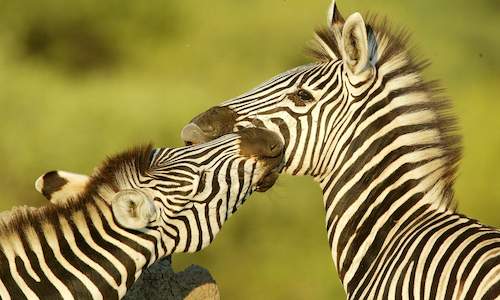
By Leigh Kemp
Wildlife Communication
New findings about Elephant communication have revolutionized the way Elephant are managed in the wilderness areas. It was recently discovered that Elephants emit ultra-sonic sounds that carry over vast distances allowing herds to avoid each other when moving.
These sounds are unheard by the human ear and what was once thought to be mere stomach rumbles in Elephant herds has been found to be communication within the herd, keeping contact with each other.
Many animals have a range of sounds depicting different emotions and situations. The Spotted Hyena has a range of 11 different calls with the most characteristic being the 'whoop' that is heard across the African savannas.
As with the Lions roar the Hyena's whoop is a contact call with two aims - to bring animals together and to keep them apart. The calls are used to communicate with members of a pride in order to locate one another or to let other individuals not of the same pride or clan know of the presence of others.
For example male Lions will roar as a territorial communication when picking up the presence of other males in the area.
Audible Communication
Generally associated with the animals' vocal abilities, communication can also be the sounds made by other body parts such as the tail or in the case of Porcupines, by the quills. Porcupine quills erect at signs of danger making the animal seem bigger and if the danger persists the Porcupine will rattle the quills in an attempt to drive the predator away.
Hares and Rabbits stomp their feet as an alarm signal. Audible communication can take the form of roars as in the Lion, grunts as in the Leopard and whistles as in the Cheetah.
Silence of the Lionesses
At Nxabega in the Okavango Delta I was observing the females and cubs of a pride of Lions feeding on a Giraffe they had killed, and as the pride had not eaten for many days the Lionesses were not taking any chances. They covered the blood and stomach contents with sand to prevent the scent of the carcass carrying too far.Not long after they had started feeding the roars of the territorial male could be heard from a distance. The Lionesses kept quiet as the calls of the male got closer. Whether they knew that the male would chase them from the carcass if they called him is not certain but they let him pass by within one hundred meters of where they were feeding and he moved off calling into the distance in an attempt to contact them.When Hyenas are in a territorial dispute with another clan, or if they are in a debate over a carcass with Lions, they will call in the rest of the clan by 'whooping'. This call and the roar of a Lion can carry for five kilometers.Warning Calls
Warning calls of Antelope vary from the 'bark' of Kudu to the whistle of Reedbuck. The reaction after the warning will depend on the predator sighted and the terrain. If the terrain is open the Antelope will keep the predator in sight, calling constantly. It is possible to follow the path of a predator by listening to the alarm calls of other animals.
The reaction of Antelope to Wild Dogs, however, is one of fear and pandemonium with the Antelope running in all directions. No other predators garner the reaction that Wild Dogs do. The reason for this may be the dogs hunting method whereby the dogs hunt in packs and are capable of chasing prey for long distances.
Predators such as Leopard and Cheetah rely on the surprise factor and camouflage to capture their prey over short distances, making it essential for the Antelope to keep the predator in sight.
The constant chattering of individuals in Monkey and Baboon troops is communication between members of the troop, keeping the troop together.
This communication is made up of grunts, squeals and barks. When danger is sighted the member of the troop that sights the danger utters an alarm call in the form of a bark or a scream which will alert the others in the troop and they will join in the warning calls.
Territories and Communication
Vocal communication is also important in the territorial battles of some animals. Male Lions patrol their home range boundaries scent marking and roaring to let other males know of their presence in the area.
When a new male, or males, arrives in the area and wants to challenge the dominant male he will leave his imprint on all the marking areas of the present male and they will engage in a vocal war as they size each other up. Territorial wars can be very loud and lengthy affairs often resulting in physical contact that sometimes results in death to one or more of the combatants.

 This Botswana Guide describes how species communicate with each other, what their alarm or distress calls mean or what their body posture te...
This Botswana Guide describes how species communicate with each other, what their alarm or distress calls mean or what their body posture te...